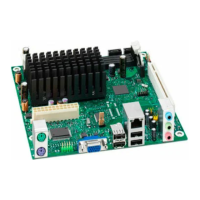Technical Reference
55
2.6.1.2 Thermal Specifications Guideline
Terms Requirements
T
A
≤ 50 °C
T
J
≤ 100 °C
Ψ
JA
≤ 3.85 °C/W
TIM Honeywell PCM45F
TDP 13 W
T
A
external ≤ 35 °C
2.6.1.3 Heatsink Design Guideline
Maximum heatsink size* 87 x 62 x 35.54 mm
Heatsink mass ≤ 80 grams
Retention type Spring loaded fasteners
Heatsink preload 11.3 +/- 3.6 lb
Note: Refers to the heatsink installed on the board.
2.6.1.4 Chassis Design Guideline
The pin fin heatsink design used on this board will be able to dissipate up to 13 W of
processor power in most of the passively enabled system chassis. This board is
targeted for 3-7 liters volumetric or larger, desktop/tower orientation, mini-ITX and
micro-ATX chassis with a chassis fan. The recommended fan type is an exhaust fan.
For best thermal performance, it is recommended that the chassis fan provide
reasonable airflow directly over the all the major components on the board. The pin fin
heatsink is designed to have the best thermal performance when airflow direction is
parallel to the heatsink fins.
The processor on the board will generate the highest amount of heat, leading to high
ambient temperature within the chassis. The chassis fan should be located near the
board region in order to effectively regulate airflow (see Figure 16). A chassis fan
located further away from the board region, i.e., at the optical disk drive or hard disk
driv
e region
, will be less effective in controlling the local ambient temperature.
Regardless of where the chassis fan is located, the maximum local ambient
temperature as defined by T
A should be capped at 50 °C. Chassis inlet vents should
also provide adequate openings for airflow to pass through. The recommended free-
area-ratio of chassis vents should be equal to or greater than 0.53. By using the
reference pin fin heatsink, most chassis with a chassis fan enabled should have local
ambient temperature safely below the 50 °C limit.

